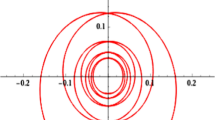Abstract
The Kepler–Heisenberg problem is that of determining the motion of a planet around a sun in the Heisenberg group, thought of as a three-dimensional sub-Riemannian manifold. The sub-Riemannian Hamiltonian provides the kinetic energy, and the gravitational potential is given by the fundamental solution to the sub-Laplacian. The dynamics are at least partially integrable, possessing two first integrals as well as a dilational momentum which is conserved by orbits with zero energy. The system is known to admit closed orbits of any rational rotation number, which all lie within the fundamental zero-energy integrable subsystem. Here, we demonstrate that, under mild conditions, zero-energy orbits are self-similar. Consequently, we find that these zero-energy orbits stratify into three families: future collision, past collision, and quasi-periodicity without collision. If a collision occurs, it occurs in finite time.



Similar content being viewed by others
References
Diacu, F., Perez-Chavela, E., Santoprete, M.: The n-body problem in spaces of constant curvature. Part I: relative equilibria. J. Nonlinear Sci. 22, 247–266 (2012)
Dods, V.: Kepler–Heisenberg Problem Computational Tool Suite. https://github.com/vdods/heisenberg (2018)
Dods, V., Shanbrom, C.: Numerical methods and closed orbits in the Kepler–Heisenberg problem. Exp. Math. 28, 420–427 (2019)
Folland, G.: A fundamental solution to a subelliptic operator. Bull. Am. Math. Soc. 79, 373–376 (1973)
Maciejewski, A., Stachowiak, T.: Nonintegrability of the Kepler and the two body problem on the Heisenberg group (2021). arXiv:2103.10495
Montgomery, R.: A Tour of Subriemannian Geometries, Their Geodesics and Applications. AMS Mathematical Surveys and Monographs 91 (2002)
Montgomery, R., Shanbrom, C.: Keplerian motion on the Heisenberg group and elsewhere, Geometry, mechanics, and dynamics: the Legacy of Jerry Marsden. Fields Inst. Comm. 73, 319–342 (2015)
Shanbrom, C.: Periodic orbits in the Kepler–Heisenberg problem. J. Geom. Mech. 6, 261–278 (2014)
Acknowledgements
The authors are grateful to Richard Montgomery for many valuable conversations. The first author would like to thank MSRI for the privilege of taking part in the Fall 2018 Hamiltonian Systems semester, during which the bulk of this project was completed.
Author information
Authors and Affiliations
Corresponding author
Additional information
Communicated by Melvin Leok.
Publisher's Note
Springer Nature remains neutral with regard to jurisdictional claims in published maps and institutional affiliations.
This material is based upon work supported by the National Science Foundation under Grant No. DMS-1440140 while the first author was in residence at the Mathematical Sciences Research Institute in Berkeley, California, during Fall 2018.
Rights and permissions
About this article
Cite this article
Dods, V., Shanbrom, C. Self-similarity in the Kepler–Heisenberg Problem. J Nonlinear Sci 31, 49 (2021). https://doi.org/10.1007/s00332-021-09709-1
Received:
Accepted:
Published:
DOI: https://doi.org/10.1007/s00332-021-09709-1




